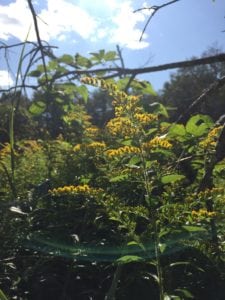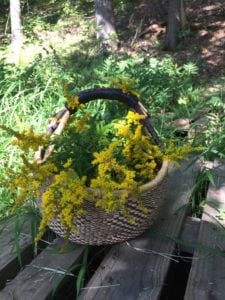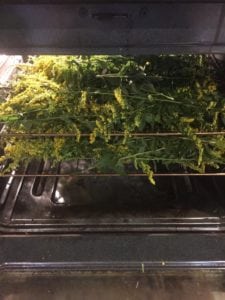Goldenrod: Herb of the Week

Many people mistakenly blame goldenrod for their runny noses and watery eyes this time of year, but in actuality, no one has seaonal allergies to goldenrod. How can i be so sure? It’s bee-pollinated! (and in fact, it’s very important late-season food for bees!) Goldenrod’s pollen is too heavy to blow through the air – but ragweed’s isn’t. Ragweed and goldenrod bloom at the same time, and while goldenrod is tall and showy, ragweed is short and its flowers are green – camoflauge! Ragweed is causing all the trouble, but goldenrod gets all the blame. You might also be surprised to hear that goldenrod can actually help fight seasonal allergies: which means you can enjoy admiring goldenrod’s beautiful blossoms knowing that they are not actually the cause of your sneezing!
Goldenrod is astringent and anti-septic, so when you have a UTI, definitely include goldenrod in your recovery protocol. It has very high anti-oxidant content, and is a potent yet gentle kidney supporter – put the two together and you’ve got that excellent support for seasonal allergies, as well! Goldenrod is fantastic topically too, for sore muscles and even bruises. AND, goldenrod is also a vulnerary – which means it stimulates wound healing. In fact, that’s where the botanical name comes from: Solidago means “to make whole”. With all that to recommend it, you can see why goldenrod is an herb I never want to run out of!

I find goldenrod delicious all by itself as tea – it has a honey-sweet flavor that reminds me of the smell of fresh hay. It doesn’t really taste like hay, but that smell is one of my favorite things, and it tastes like i feel when i smell that. You can also make goldenrod tincture or goldenrod elixir – which would be doubly amazing if you can get your hands on goldenrod honey! Our local honey shop, Follow the Honey, often has goldenrod honey on tap – you may be able to find some near you as well. Basically, any way you can get goldenrod in to you is good!

Just loosely pile your goldenrod on your oven racks, and every few hours, turn the oven on just long enough for it to start to warm up – but NOT long enough to really start getting hot. Ninety seconds will usually do it. The goal here is to try to keep it somewhere around 100 degrees, so that everything gets dry and crispy, but not to let it heat up so much that you burn any of it. It might take a couple days, but you’ll end up with nicely dried goldenrod!
What’s YOUR favorite way to work with goldenrod? Let us know in the comments!
#herboftheweek
2 Comments
Leave a Comment
You must be logged in to post a comment.

Join our newsletter for more herby goodness!
Get our newsletter delivered right to your inbox. You'll be first to hear about free mini-courses, podcast episodes, and other goodies about holistic herbalism.


[…] include violet, betony, kava, pedicularis, green tea, calamus, pine, elecampane, sage, tulsi, goldenrod, […]
[…] discussed include: loosestrife, elderberry, ground ivy, mullein, boneset, sumac, goldenrod, st john’s wort, japanese knotweed, catnip, & blue […]